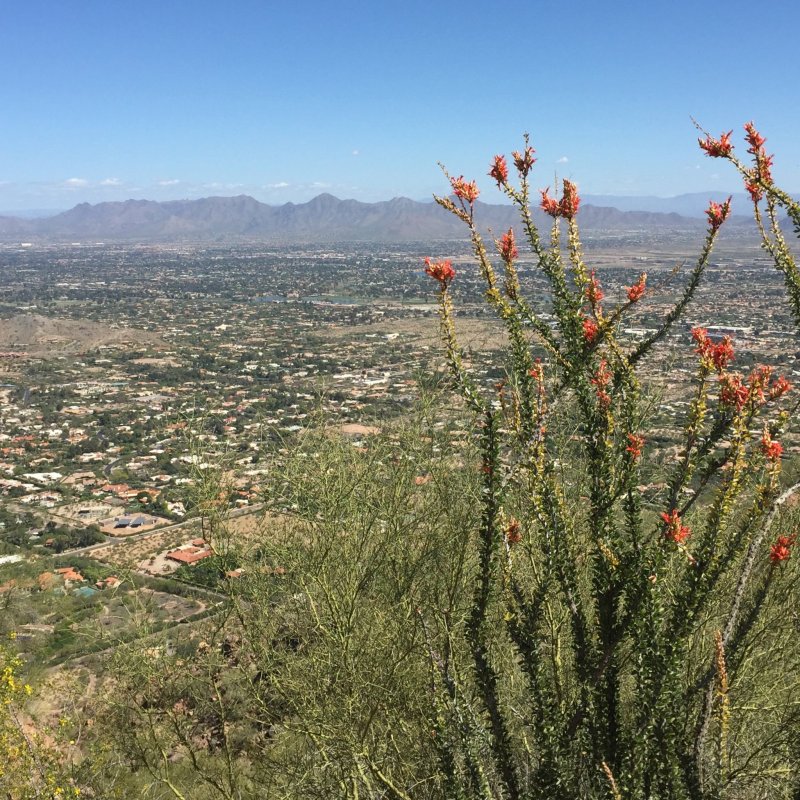
With its famous humps that resemble the back of a kneeling camel, Camelback Mountain is among Arizona’s most iconic landmarks. It is a distinctive promontory on the Phoenix skyline and is visible from all over the Phoenix/Scottsdale metro area.
Videos by TravelAwaits
So, it makes sense that thousands of people gravitate each year to the trails that lead to the mountain’s summit. Hiking Camelback is consistently listed as a top 10 attraction in Phoenix, and it is considered one of the best urban hikes in the United States.
But despite its accessibility right in the middle of the nation’s fifth-largest city, it is best not to underestimate Camelback Mountain. Many websites rate the climb as “difficult” or “extremely difficult,” and helicopter rescues seem to happen on the rugged mountainside every year.
I have climbed Camelback Mountain a number of times in various seasons, and it is a wonderful hike, featuring stunning views of Phoenix’s sprawling Valley of the Sun, as well as gorgeous, flowering cacti and wildflowers in the spring.
Still, I always think about those rescues, often televised on the Phoenix news, that show injured or stranded hikers being airlifted off the mountain. As I start on the hike up, I remind myself to take extra care in the hopes that I don’t end up on that evening’s newscast.
Most hikers know that virtually any trail comes with some level of risk — a sprained ankle, a fall, or a missed turn. But because of the extreme terrain and weather, Camelback has its own set of challenges.
Here are 12 tips for successfully hiking up and down Camelback Mountain.

1. Pick The Right Season
It really should go without saying that climbing Camelback Mountain in the heat of a desert summer is a bad idea. Phoenix summer temperatures regularly climb to 110 degrees and above. Nighttime does not provide much relief, with temperatures often remaining at 90 degrees or hotter throughout the night.
The best times to climb Camelback are the late fall, winter, and early spring. November’s average highs are in the mid-70s, while December and January’s highs are in the 60s. February and March are arguably Phoenix’s loveliest months, with wildflowers beginning to bloom and average high temperatures in the 70s. But remember that those months are also the most popular with Phoenix’s winter and spring visitors, so the trails tend to be crowded.
2. Assess Your Fitness Level
Before you set out on a climb up Camelback Mountain, it is important to do a candid evaluation of your fitness. The trail climbs 1,200 to 1,300 feet in just over a mile, so hikers should expect some very steep terrain, with many high step-ups.
Also, the hike includes sections where you will need to use hands and arms to help propel yourself over the rocks. After I finish a Camelback hike, I’m always surprised to feel stiffness in my arms and shoulders, making me realize that the hike is a workout for the upper body as well as the lower body.
Hikers who are having difficulty should remember that there is no shame in turning back when the going gets especially rocky and steep. I have seen many people hike the first, more gradual section of the Cholla Trail and turn back as the trail goes vertical in the final one-third or so. They still get to experience great views and desert terrain.

3. Choose The Right Trail
There are two main trails leading to Camelback’s summit — the Cholla Trail and the Echo Canyon Trail. Each has its pros and cons.
The Cholla Trail is longer, at about 1.5 miles one-way, making the climb a bit more gradual. The first mile climbs steadily along a route that is fairly easy to follow. The final half-mile or so transitions to steep terrain that requires rock scrambling.
At about 1.2 miles one-way, the Echo Canyon Trail is somewhat shorter and therefore steeper. The final ascent requires the use of handrails. Unlike the Cholla Trail, the Echo Canyon Trail features a trailhead with restrooms, benches, and water.
Both hikes are scenic. Fit hikers can expect to take anywhere from one to three hours on either of the routes.
Editor’s Note: Both trails are rated as extremely difficult. Cholla Trail is currently closed for maintenance.
4. Get An Early Start
Along with choosing the right season, the time of day is equally important in successfully hiking Camelback Mountain. The main reason for getting an early start is that morning temperatures will be cooler. In September and October, a 7 a.m. start might yield temperatures in the high 70s or low 80s, while 2 p.m. could be climbing toward 100 degrees or hotter.
Another reason to start early is the limited parking available. Although parking was recently expanded at the base of Echo Canyon, there are still more users than spaces. Getting there at about sunrise when the trailhead opens is recommended.
The Cholla Trail has no official parking lot, so trail users park along the busy Invergordon Road. The on-street parking tends to fill up as well, and during busy times, hikers end up parking blocks away from the trail.
Pro Tip: Locals suggest biking or taking an Uber to the trailhead to avoid the hassle of finding parking.

5. Carry Plenty Of Water
Although water is available at the trailhead of the Echo Canyon Trail, there is no water source along either of the routes up, so it is crucial to carry enough water.
Even if you’re hiking in the cooler winter months, the sun can be brutal. Most experts suggest taking more water than you think you’ll need — a liter or more per person. Signs along the trails caution that if you are half out of water you should turn back.
6. Take Salty Snacks
Regardless of when you hike Camelback Mountain, it is a good idea to have a snack or two on hand to keep up your energy levels. Salty snacks like nuts and pretzels are great for an energy boost and for replenishing the sodium your body will lose by sweating on the trail.

7. Wear Sturdy Shoes
Thick-soled hiking shoes or boots are optimal for hiking the rough terrain of Camelback Mountain. Even though I swear by my sturdy hiking sandals for most Arizona hikes, Camelback is one where close-toed shoes are best. Many people hike the trail in sneakers, which are okay if they have a thick sole to guard against the sharp rocks. A good tread is also advisable for traction on the rocky sections.
8. Don’t Forget A Hat
I would never venture out on any Arizona trail without a hat or cap, and headgear is especially important on Camelback because of the lack of consistent shade and the bright Phoenix sun. A bandana around your neck is also helpful.

9. Watch For Reptiles
With its location in the midst of the Sonoran Desert, Camelback Mountain is home to a variety of wildlife, including snakes and lizards.
Although I’ve never encountered a rattlesnake on the Camelback trails, I know they are there. Rattlesnakes are typically active in the Arizona desert from about April through October. The month of September, with its still-hot weather but cooler mornings, is known as prime rattlesnake season.
To avoid a rattlesnake encounter, experts suggest always looking where you’re stepping and avoiding blindly reaching under a rock or into a crevice. It’s also best not to wear earbuds while hiking because rattlesnakes tend to give a warning rattle when a person gets near. If you see a rattlesnake along the trail, avoid it by widely skirting it or turning back. Also, hikers should warn others of the potential danger as they continue on the trail.
Lizards are plentiful on almost all Arizona trails, and I have seen many of them while hiking on Camelback Mountain. Although they might startle you, most Arizona lizards tend to be harmless (except for the venomous Gila monster). The distinctive looking, but non-poisonous, Chuckwalla lizards are often seen basking in the sun on the rocks along the trail.
10. Remember Trail Etiquette
There will be numerous times on the Camelback trails when you will encounter narrow stretches of trail where two hikers cannot pass. In those instances, remember that the uphill hiker has the right-of-way.
That means that if you’re coming down, you should get over to allow the upward hiker to pass uninterrupted. It is common trail etiquette, and it allows for safe and consistent passage along the trail.

11. Soak Up The Views
Once you make it to the top of Camelback Mountain, don’t forget to take some time to enjoy the views. The Phoenix tourism website describes the vista as “an uninhibited 360-degree panorama of greater Phoenix and beyond.”
There are a number of rocks and ledges at the summit where you can sit for a rest and a leisurely look around. By this time, you’ve definitely earned a long drink of cool water and a salty snack!
12. Take Your Time On The Way Down
Despite the feeling of accomplishment of reaching the summit, remember that you still have the hike back down, which, like with many steep trails, offers a challenge of its own. The steep rocks that seemed mainly strenuous on the way up tend to be even more precarious on the way down.
The best strategy: Take your time, and rest when the terrain allows.
Pro Tips
Trailhead hours are sunrise to sunset, so plan your hike accordingly. Also, if you’re traveling with the family pet, remember that dogs are prohibited at all Echo Canyon and Cholla trail areas.
For a list of easier desert trails in Phoenix, check out this article.
